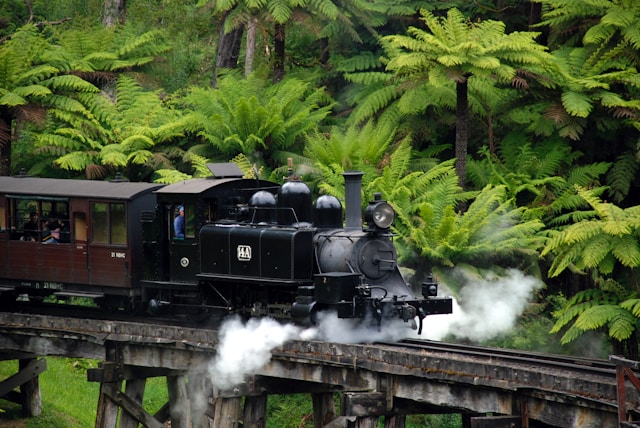Australia’s romance with steam trains began in the mid-19th century, a time when railways were revolutionizing travel and industry around the world. The first steam train journey in Australia took place on September 12, 1854, marking the beginning of a transformative era. This momentous event occurred on the Melbourne and Hobson’s Bay Railway Company line, running from Melbourne to Sandridge, now known as Port Melbourne. This initial line was just 4.5 kilometers long but set the stage for the rapid expansion of rail infrastructure across the continent.
The Early Days – Establishing the Network
The growth of Australia’s rail network in the late 1800s was nothing short of explosive. By the 1880s, railways had spread to every colony, facilitating the movement of goods and people in ways previously unimaginable. Victoria, New South Wales, and Queensland led the charge, each developing extensive networks that connected major cities with regional areas. The diversity of gauges used by different colonies, however, presented a significant challenge. Standard gauge, broad gauge, and narrow gauge lines created logistical nightmares, particularly at the borders. This issue wasn’t fully resolved until the latter half of the 20th century when efforts to standardize the rail gauges gained momentum.
Iconic Steam Locomotives
Australia saw the introduction of many iconic steam locomotives during this period, each contributing to the nation’s rail heritage. The NSWGR C38 class, introduced in the 1940s, was one of the most famous. These powerful Pacific-type locomotives were used primarily for express passenger services, and their sleek, streamlined design made them a favorite among rail enthusiasts. Another noteworthy mention is the Victorian Railways H class, massive locomotives designed for heavy freight work. These giants of the railways were a testament to the engineering prowess of the era and played a critical role in the economic development of the regions they served.
The Golden Age – Expansion and Innovation
The early 20th century was a golden age for steam trains in Australia. Railways became the lifeblood of the nation, facilitating commerce, travel, and communication. Innovations in locomotive design and railway technology during this period were remarkable. The introduction of more efficient and powerful engines allowed for longer and faster journeys. One of the most significant developments was the construction of the Trans-Australian Railway, completed in 1917, which connected Port Augusta in South Australia to Kalgoorlie in Western Australia. This 1,693-kilometer line traversed the vast, arid Nullarbor Plain and remains one of the most remarkable engineering feats in Australian history.
Railway Communities and Culture
The expansion of the rail network also had profound social and cultural impacts. Railway towns sprang up along major routes, becoming bustling hubs of activity. These towns were often characterized by their tight-knit communities, with the local railway station serving as a focal point of daily life. The railway culture permeated many aspects of society, influencing everything from employment patterns to leisure activities. Trainspotting became a popular hobby, and the sight of a steam locomotive chugging through the countryside became a symbol of progress and adventure.
The Decline and Preservation of Steam
The mid-20th century saw the decline of steam trains as diesel and electric locomotives began to dominate. The efficiency and lower operating costs of these new technologies spelled the end for steam in regular service. By the late 1960s, steam locomotives were being phased out across Australia, replaced by more modern alternatives. However, the legacy of steam trains was far from forgotten. Enthusiasts and preservation societies have played a crucial role in keeping the history of steam alive. Organizations like the Puffing Billy Railway in Victoria and the Zig Zag Railway in New South Wales have preserved historic locomotives and restored them to working order, allowing new generations to experience the magic of steam travel.
Preservation Efforts and Tourist Railways
Today, Australia boasts a number of heritage railways where steam locomotives continue to run, offering a nostalgic glimpse into the past. The Puffing Billy Railway, one of the most popular tourist railways in the country, operates on a narrow-gauge line originally opened in 1900. This charming railway winds through the scenic Dandenong Ranges, providing visitors with a unique and picturesque journey. Other notable heritage railways include the Bellarine Railway in Victoria and the Valley Heights Locomotive Depot Heritage Museum in New South Wales. These attractions not only preserve historical artifacts but also educate the public about the importance of railways in Australia’s development.
Impact of Steam Trains on Australian Society
The introduction and expansion of steam trains had a profound impact on Australian society, influencing various aspects of life and development. Here are some key areas where steam trains made a significant difference:
- Economic Growth: The railways facilitated the efficient transportation of goods, including agricultural products, minerals, and manufactured items, boosting trade and commerce across regions.
- Urbanization: Railway lines connected remote areas with major cities, leading to the growth of towns and urban centers along the routes, contributing to the population’s shift from rural to urban areas.
- Employment Opportunities: The construction and operation of railways created numerous jobs, from laborers and engineers to station masters and conductors, supporting the livelihoods of many Australians.
- Social Connectivity: Trains made travel more accessible and affordable, allowing people to visit family and friends in distant locations, fostering stronger social bonds and cultural exchange.
- Tourism and Leisure: Scenic railway journeys became popular tourist attractions, promoting domestic tourism and providing people with the opportunity to explore Australia’s diverse landscapes in comfort and style.
- Technological Advancements: The development of steam locomotives and rail infrastructure drove innovation and technical expertise, contributing to advancements in engineering and manufacturing industries.
The history of steam trains in Australia is a tale of innovation, expansion, and enduring legacy. From the early days of rail travel to the preservation efforts of today, steam locomotives have left an indelible mark on the nation’s landscape and culture.



